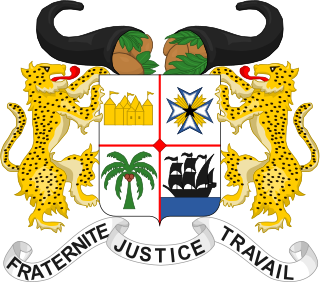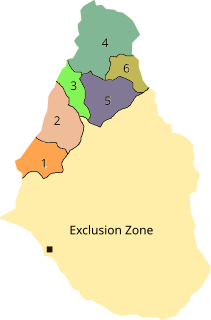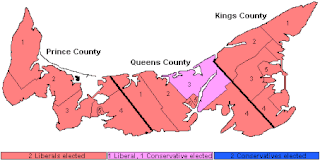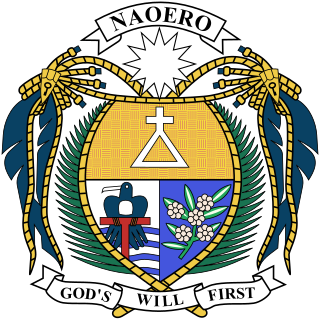
Fiji has held 10 general elections for the House of Representatives since becoming independent of the United Kingdom in 1970; there had been numerous elections under colonial rule, but only one with universal suffrage. In this period, Fiji has had three constitutions, and the voting system has changed accordingly. Note that there are no general elections for the Senate: The 32 Senators are nominated, not elected.

The Legislative Assembly of Prince Edward Island, along with the Queen of Canada in Right of Prince Edward Island, represented by the Lieutenant-Governor of Prince Edward Island, forms the parliament of the province. The General Assembly meets at Province House, which is located at the intersection of Richmond and Great George Streets in Charlottetown.
Elections in South Africa are held for the National Assembly, provincial legislatures and municipal councils. Elections follow a five-year cycle, with national and provincial elections held simultaneously and municipal elections held two years later. The electoral system is based on party-list proportional representation, which means that parties are represented in proportion to their electoral support. For municipal councils there is a mixed-member system in which wards elect individual councillors alongside those named from party lists.

There are four types of elections in Spain: general elections, elections to the legislatures of the autonomous communities, local elections and elections to the European Parliament. General elections and elections to the legislatures of the autonomous communities are called after the mandate of the national or regional legislature expires, usually four years after the last election, although early elections may occur. Elections to local councils and to the European Parliament are held on fixed dates. For most elections party list PR is used, but the plurality system is used for the Senate.

Elections in Belgium are organised for legislative bodies only, and not for executive functions. Direct elections take place for the European Parliament, the bicameral Federal Parliament, the Parliaments of the Communities and Regions, the provincial councils, the municipal councils and a few district councils. Voting is mandatory and all elections use proportional representation which in general requires coalition governments.

Elections in Benin take place within the framework of a multi-party democracy and a presidential system. Both the President and the National Assembly are directly elected by voters, with elections organised by the Autonomous National Electoral Commission (CENA).
India is a federation with a parliamentary system governed under the Constitution of India, which defines the power distribution between the union, or central, government and the states.

Philippine elections are of several types. The president, vice-president, and the senators are elected for a six-year term, while the members of the House of Representatives, governors, vice-governors, members of the Sangguniang Panlalawigan, mayors, vice-mayors, members of the Sangguniang Panlungsod/members of the Sangguniang Bayan, barangay officials, and the members of the Sangguniang Kabataan are elected to serve for a three-year term.

Elections in Montserrat take place within the framework of a multi-party democracy and a parliamentary system. The Legislative Assembly is directly elected, and a Chief Minister is selected by the party or coalition with the most seats in the Assembly.
The Edmonton provincial electoral district existed in two incarnations from 1905 - 1909 and again from 1921 - 1955, with the city broken up into multiple constituencies in the other time-periods. The district was created when Alberta became a province, to encompass residents of the city of Edmonton on the northside of the North Saskatchewan River For a time, it was one of three multi-member constituencies in the province's history, the others being Calgary and Medicine Hat.

General elections were held in Fiji between 26 September and 8 October 1966, the last before independence in 1970 and the first held under universal suffrage. The result was a victory for the Alliance Party, which won 23 of the 34 elected seats. Its leader Kamisese Mara became the country's first Chief Minister the following year.

The 1993 Prince Edward Island general election was held on March 29, 1993.

The 1974 Prince Edward Island general election was held on April 29, 1974.

The 1951 Prince Edward Island general election was held in the Canadian province of Prince Edward Island on April 26, 1951.

Landstinget was the upper house of the Rigsdag, from 1849 until 1953, when the bicameral system was abolished in favor of unicameralism. Landstinget had powers equal to the Folketing, which made the two houses of parliament hard to distinguish.
The Danish Landsting election of 1943 was held on 6 April 1943, with the exception that the electors were elected on 23 March. Along with the corresponding Folketing election, it was the first election during the German occupation, and although many people feared how the Germans might react to the election, the event took place peacefully.

Shura Council elections were held in Egypt between 29 January and 22 February 2012. The Freedom and Justice Party emerged as the largest party in the Council, winning 105 of the 180 elected seats.

Elections for the Local Government Council were held for the first time in Nauru on 15 December 1951.

Elections for the Local Government Council were held in Nauru on 10 December 1955.

Parliamentary elections were held in Portugal on 8 and 17 October 1826.

















